この記事では、IELTSライティング タスク1、特に折れ線グラフで使える単語・表現・テンプレートについて詳しく解説していきます。これを読むことで、タスク1に関する理解が深まり、7.0くらいのスコアが狙えます。記載の内容を意識・実践することで筆者は実際に7.0を取得しました。また、理系大学院生としてこれまで3本の研究論文を英語で執筆しました。この記事がみなさんの役に立てれば幸いです!
アカデミックライティングの注意点
アカデミックライティングにはいくつかのルールが存在し、それをIELTSで破ると減点されます。英文を書くときは以下のルールを守りましょう。
- don’tやIt’sなどの短縮形は使わず、do not、It is と書く。
- スラングを使わない。
- 主観的な意見を述べない(タスク1のみ)。
- イディオムや句動詞をなるべく避ける(put up with→endure/standにする)。
- And、so、also、butを文頭に置かない。代わりに、In addition/additionally、therefore、howeverなどを用いる。
- 主語にIをなるべく使わない。
- 内容の異なる文を始める際は、以下のどちらかに従う。
例1:段落なし+改行あり
Introduction introduction introduction introduction introduction introduction introduction introduction introduction introduction introduction.
Overview overview overview overview overview overview overview overview overview overview overview overview overview overview overview.
Body1 body1 body1 body1 body1 body1 body1 body1 body1 body1 body1 body1 body1 body1 body1 body1 body1 body1 body1.
例2:段落あり+改行なし
Introduction introduction introduction introduction introduction introduction introduction introduction introduction introduction introduction.
Overview overview overview overview overview overview overview overview overview overview overview overview overview overview overview.
Body1 body1 body1 body1 body1 body1 body1 body1 body1 body1 body1 body1 body1 body1 body1 body1 body1 body1 body1.
タスク1の文章構成
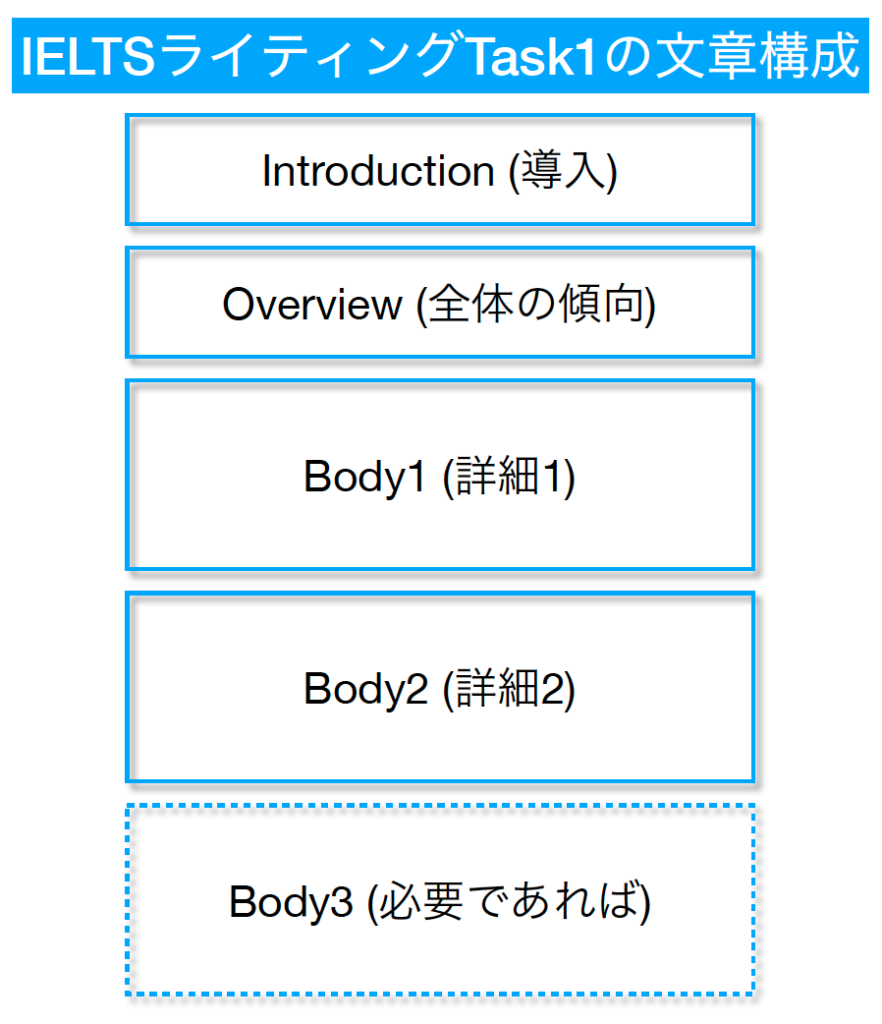
ライティングで6.0以上を目指すのであれば、上記のような構成が大前提となってきます。Introduction、Overview、Body1、Body2・・・という構成です。文字数は150字以上。タスク2と異なり、タスク1ではConclusion(結論)を書かなくても減点になりません。文字数が足りない時に書くと良いと思います。ここ最近は150字以上書かなくても減点されないとも聞いていますが、150字以上書いたほうが安全ですし、今後ライティングスコア7.0以上目指す上で、10〜20分以内で150字を書く力は必須だと思うので、150字以上を目指しましょう。
文字の数え方は以下のとおりです。
The percentage increased over the period. →6文字
The product is cost-effective. →4文字
cost-effectiveのようにハイフンで繋がれた文字は1字とみなされるので字数ギリギリの方は気をつけましょう。
It increased to 80%. →4文字
It increased to 80 percent. →5文字
記号の%は文字としてカウントされませんが、percentと書くことで、1文字とカウントされます。
It was the highest in 1995 (85%). →7文字
括弧は1文字としてカウントされません。
具体的な書き方
設問:The graph shows the consumption of three spreads from 1981 to 2007.
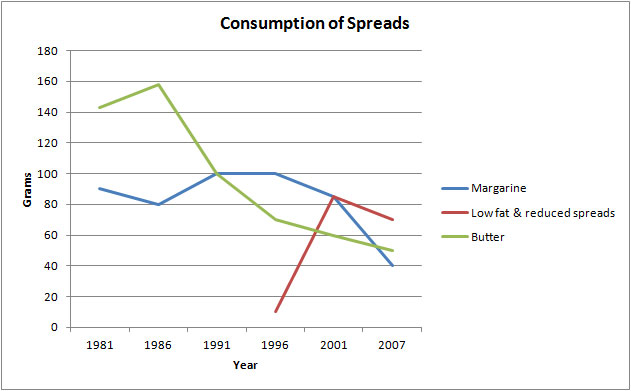
Introduction
Introductionでは、設問のパラフレーズ(言い換え)を行います。例えば、上記のような設問とグラフが来た場合。
- The presented line graph illustrates the amount of three different spreads (margarine, low and reduced spreads, and butter) that were consumed from 1981 to 2007.
上記のように設問に書かれている語彙をなるべく使わずに、自分の言葉で問題を言い換えます。
Overview
Overviewでは、グラフの一般的なトレンドを説明します。この際、詳細な数字などは書かずに、傾向・順位の変動などの説明で十分です。
- Overall, the consumption of margarine and butter experienced a downward trend, whereas the low fat and reduced spreads had risen over the period in question. Initially, butter was the most popular; however, the low fat and reduced spreads had overtaken both margarine and butter at the end of the duration.
Body
Bodyでは具体的なグラフの説明に入ります。このセクションでは、傾向が一致している物で分類すると書きやすいです。今回のグラフでは、マーガリンとバターが減少傾向にあるので、この2つをBody1に書きます。また、low fat and reduced spreadsは上昇したので、これをBody2に書きます。
Bodyを書く際に気をつけてほしいのが、文法です。同じ文法ばかりを使っていると、高得点が望めないので、There is/are構文、不定詞、動名詞、関係代名詞、分詞構文、ディスコース・マーカー(First、Second、In additionなど)を満遍なく使いましょう。特に、今回のようにグラフの期間が過去の場合(例:1981〜2007年のグラフ)過去完了形が使えるので、積極的に使いましょう。
もう一つ、Bodyを書く際に気をつけたいのが、「比較」を必ず入れることです。問題文には必ず、Summarize the information by selecting and reporting the main features, and make comparisons where relevant.という記述があり、比較を怠ると、7.0以上の高得点が狙えなくなります。なので、Body1及び2に比較を散りばめるか、Body3を新たに作って、そこで比較をするのがいいと思います。
使える語彙・表現集
以下にタスク1で使える語彙・フレーズを、一部例文付きでまとめました。
- increase (an increase)
- rise (a rise) 過去形: rose、 過去分詞形: risen
- grow (a growth) 過去形: grew、 過去分詞形: grown
- go up
- see/experience/go through an upward trend
- rocket アカデミックライティングではあまり使わない
- jump アカデミックライティングではあまり使わない
- climb アカデミックライティングではあまり使わない
- decrease (a decrease)
- fall (a fall) 過去形: fell、 過去分詞形: fallen
- drop (a drop)
- decline (a decline)
- go down
- see/experience/go through a downward trend
- sharply/quickly/rapidly/steeply (急速に・急激に)
- considerably (かなりの程度に)
- significantly/dramatically/drastically (大幅に)
- substantially (実質的に)
- steadily (着実に)
- gradually (徐々に)
- moderately (適度に)
- slightly (わずかに)
- slowly (ゆっくりと)
- fluctuate (a fluctuation)
- oscillate (an oscillation) 周期が一定の時しか使えない、例:sinθの関数など
- a zigzag trend
- stay/remain the same
- stay/remain stable
- stay/remain constant
- level off
- plateau (a plateau)
例:The number of ownership remained the same/stable/constant/leveled off/plateaued in 2005.
- peak
- reach the peak
- hit a high point
例:The production of onions peaked/reached the peak/ hit a high point in 1996, which was about 3 million tons.
- hit bottom
- hit a low point
例:In 1998, the amount of hit bottom/a low point.
- period
- term
- duration
例:Overall, the number of tourists had increased over the period/term/duration in question.
- over the first XX years(最初のXX年間)
- over the last XX years(ここXX年間)
- from A to B/ between A and B(A年からB年まで/ A年からB年の間)
- at the biggening of the period(その期間の初めに)
- at the end of the period(その期間の終わりに)
- the following year(その翌年)
- a decade(10年)
- a century(100年)
- every XX years(XX年おき)
例:The number of tourists dropped to 2.5 million in 2005. It further decreased to 1.1 million the following year, hitting a low point.
- subsequently
- then
- after which
例1:The percentage sharply increased to 78% and subsequently/then plateaued.
例2:The percentage reached about 65% in 2002, after which, it dropped to approximately 44% in 2004.
解説:after whichの前後をコンまで挟んで、その後はS+Vと続く。
- in terms of 〜
- with respect to 〜
- regarding 〜
- as for 〜
- when it comes to 〜
- as regards 〜
- whereas
- while アカデミックライティングではあまり使わない
- on the other hand
- however
- although
- even though
- despite
- in spite of
- in contrast (to)
- as opposed (to)
例1:The male crime rate experienced an upward trend, whereas that of females saw a downward trend over the period.
解説:whereasの直前に必ずコンマを置く
例2:Although the male crime rate experienced an upward trend, that of females saw a downward trend over the period.
解説:althoughの節が終わる際に必ずコンマを置く
例3:The male crime rate experienced an upward trend; however, that of females saw a downward trend over the period.
解説:howeverを接続詞として使う際は、セミコロン;を前に、コンマを後に必ず置く。
例4:Despite the increasing male crime rate, that of females saw a downward trend over the period.
解説:despiteは前置詞なので、後に名詞が続く。
例5:Despite the male crime rate experiencing an upward trend, that of females saw a downward trend over the period.
解説:despiteの後に主語、動詞を有する文を続けたい場合、動詞をing形にする。
例6:In contrast/as opposed to the male crime rate experiencing an upward trend, that of females saw a downward trend over the period.
解説:as oppose/in contrast toの後に主語、動詞を有する文を続けたい場合、動詞をing形にする。シンプルに名詞のみを書くのも可。
- about
- approximately
- nearly
- almost
- around アカデミックライティングではあまり使わない
解説:about/approximately 70%は65〜75%くらいのときに使える。一方、nearly/almost 70%は65〜69%の範囲でしか使えない。
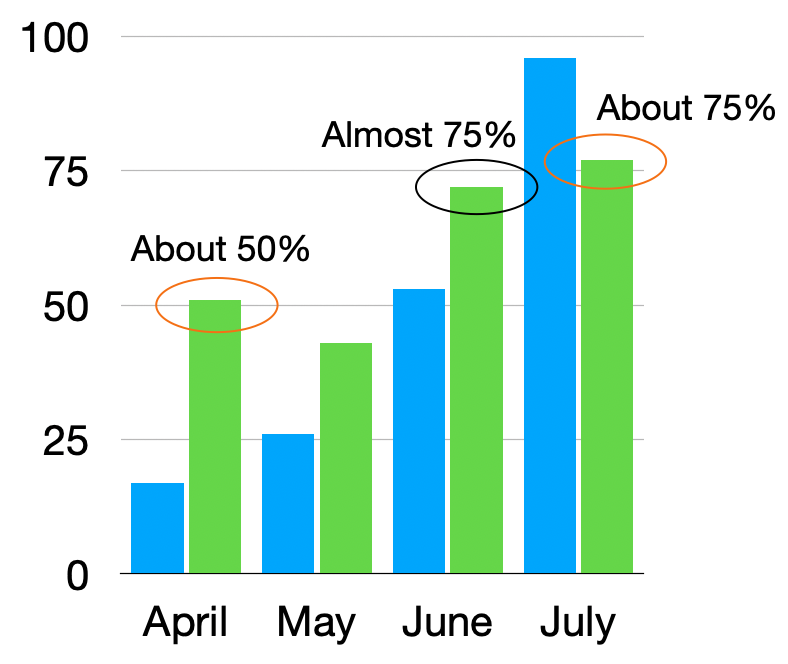
- overtake
- exceed
- surpass
- take over
例:At the end of the period, China overtook/exceeded/surpassed/took over Japan in GDP by a wide margin.
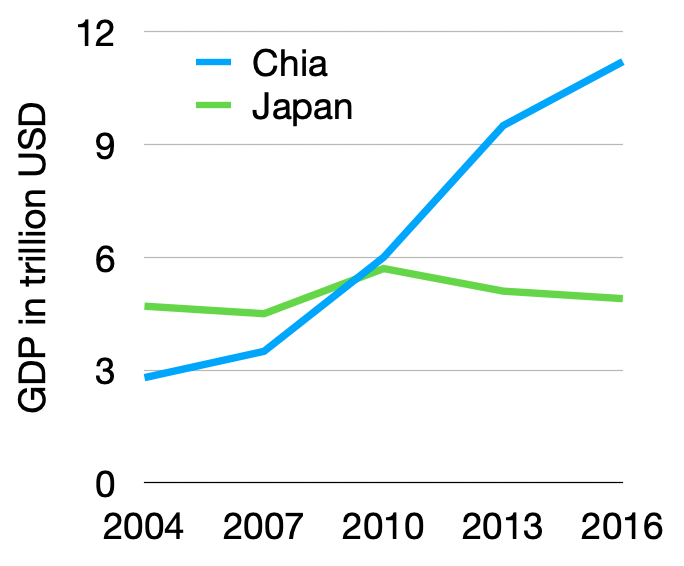
- double
- triple
- X-fold/times(X倍)
- half
- one-third
- quarter
- 数字-序数(序数分の数字、例:two-fifth 2分の5)
例:The number of American visitors doubled/tripled/increased 4-times.
- in addition (to)
- additionally
- besides アカデミックライティングではあまり使わない
- moreover
- furthermore
これらの単語は主に文頭で使われ、単語の後に必ずコンマを置く。
例:In addition, an aging society might be one of the causes of it.
今回の記事は以上になります。何か追記してほしいことや、質問などがあれば是非コメントでお知らせください!
棒グラフ、地図などタスク1でよく出題される問題についても同様にまとめるつもりです。少々お待ち下さい。

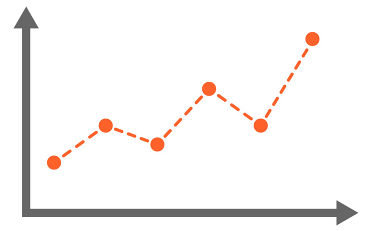


コメント